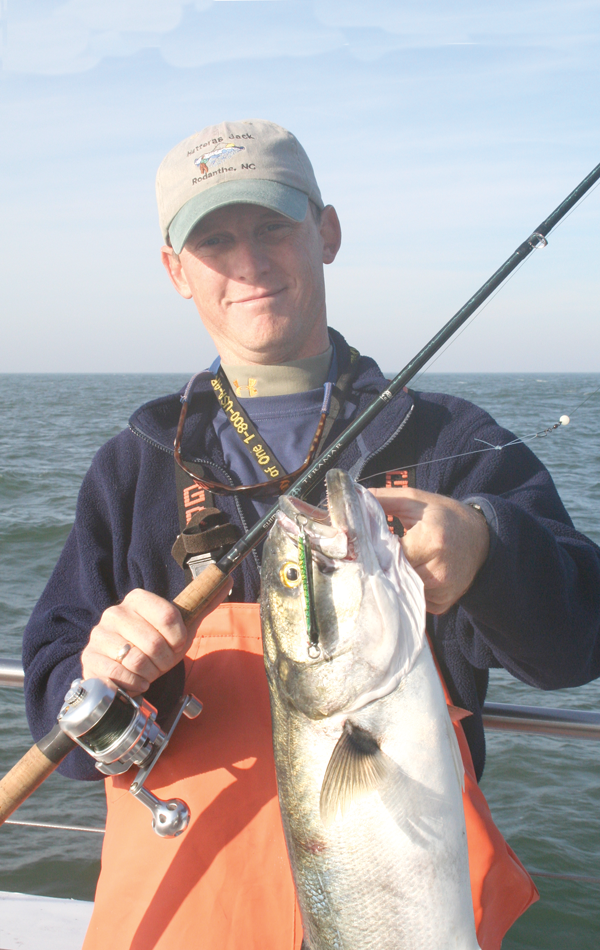The Chesapeake Bay used to draw large numbers of big bluefish every spring, and even larger numbers of fishermen trying to catch them. I fished out of Chesapeake Beach, Tilghman Island, Kent Island, Point Lookout, and Sandy Hook during those days and either trolled, chummed, or cast surface lures to large schools of hungry blues. Today, big blues are hard to come by in the Bay, but there are plenty of them in the ocean, so it is always possible they could return.

There are several unproven theories as to why the big blues left the Bay. One states that a fleet of purse seiners entered the Lower Bay, scooped up all the big blues and left. Then we have Maryland’s excuse for everything that’s wrong with every fishery—Virginia. The Virginia menhaden fishery catches all the menhaden in the Bay, thereby removing the foodfish required for blues to enter the Bay.
Since I am just as qualified to an opinion as most of those who give theirs around the docks or on social media, here it is. Bluefish don’t follow anyone’s rules. They go where the water temperature suits their body and there is plenty of bait for their bellies.
We had unprecedented runs of big blues in the lower Delaware Bay for a couple of years, and then in 2018 only a few showed up. Naturally, we are all hoping they come back in 2019, but I have my doubts.
During the February sea bass season in Virginia, reports indicated plenty of big blues over wrecks beyond 20 fathoms. Tog fishermen working structure closer to shore did not encounter any big blues.
When I moved to Virginia Beach in 1989, they had an excellent fishery for big blues around the tunnels of the Chesapeake Bay Bridge Tunnel. It was all on surface lures, and a friend Dr. Trent made them out of dowels with a wire run through ending with a treble hook (a tad primitive, but effective).
During my time there I saw something I had never seen before or since. I had my son Roger and friend Keith Kauffman on my 24-Albemarle trolling for rockfish, and we had no luck. We started at the Concrete Ships on the Eastern Shore and ended over the tube at the Fourth Island.
We were wire-line trolling when Keith’s rod bent over, and I thought he had a big rockfish. Turned out, he had a big blue.
As he was fighting that fish, I noticed surface activity closer to the island. Once the fish was in the cooler, I ran over to see what was going on. The big blues had small rockfish herded into balls and were picking them off one at a time, much like a party guest biting a carrot stick in half from a vegetable tray. When I say small rockfish, they were all 20 to 26-inch fish. There were at least five or six of these bait balls that I could see.
Many years ago, Bob Pond gave me several of his Atom poppers that had come out of the mold disfigured. He said if I ever ran into a bluefish blitz, these lures would be perfect. I broke them out, and we all began catching big blues as fast as we could drag one of Bob’s disfigured creations across the water anywhere near the bait balls.
I have no idea how many big blues we caught and released, keeping only a few that were hooked deep. I do know we lost all of the Atom plugs, and the mono on my reels had to be replaced because it was stretched beyond its limit.
I am afraid if you want to tangle with big blues in 2019, you will have to go out to the ocean. As much as I would love to see them move back into the Chesapeake Bay, I don’t think it will happen. I have no idea why; that is just the way of the bluefish.
We are covered up with menhaden in the Delaware Bay and near-shore waters of the ocean and yet we haven’t seen big blues in two years. As I said before, they just go where they please with no apparent reason to the logical human mind. Keep checking the fishing reports in Lenny Rudow’s FishTalk, and if you hear of big blues showing up somewhere, head there as soon as possible.
By Eric Burnley